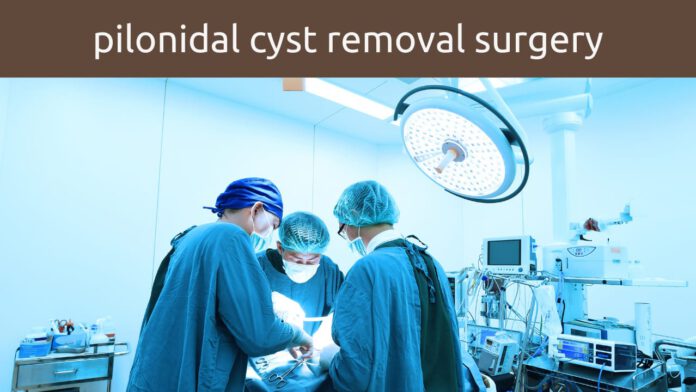A pilonidal cyst is the unnatural growth of skin that is filled with ingrown hair and pus. They usually occur at the bottom of your tailbone. The healing period after pilonidal cyst removal surgery depends on the type of procedure you receive. The duration for recovery is determined depending on whether it is a closed or open surgery.
Pilonidal cysts are caused when the ingrown hair penetrates beneath the skin. There are two primary procedures to treat a pilonidal cyst. This includes:
- Incision and drainage: In this procedure, the doctor will make a small incision and drain the pus or other unwanted materials inside the cyst.
- Pilonidal cystectomy: In this procedure, the doctor removes the entire cyst and the tissues around it.
Suitable candidates for pilonidal cyst removal surgery
1) Incision and drainage
Your healthcare physician will recommend an incision and drainage procedure if:
- You have a minor infection
- This was your first treatment for a pilonidal cyst
About 60% of the time, an incision and drainage procedure is successful in treating a pilonidal cyst. To maintain the results, doctors often recommend people undergoing the procedure to try hair removal procedures to prevent other infections. This includes waxing, shaving, and laser hair removal.
2) Pilonidal cystectomy
Your healthcare physician will recommend a pilonidal cystectomy procedure if:
- You have undergone an incision and drainage procedure but your cyst return
- You have a severe infection
- You have several cysts with sinus tracts
Potential risks of a pilonidal cyst removal surgery
Incision and drainage is the most common procedure used in treating a pilonidal cyst because it rarely causes serious complications. However, you can experience pain after this procedure but this can be easily relieved by a pain reliever.
On the other hand, a pilonidal cystectomy procedure often results in scarring. However, this scar will gradually fade away with time. Like other surgical procedures, incision and drainage and pilonidal cystectomy procedures can lead to infections. Therefore, you must look out for the following symptoms:
- Redness
- Tenderness
- Oozing pus
- Fever or chills
- Warm to be touch (heat coming from the wound)
Other potential complications can include:
- Poor healing
- Hematoma (bruise)
- Recurrence of pilonidal cyst
- Seroma (fluid buildup)
Since there is a high chance of recurrence even after the treatment, you may have to undergo more than one procedure for cyst removal.
Preparing for a pilonidal cyst removal surgery
Here’s how you can prepare for each procedure:
a) Incision and drainage
In incision and drainage procedures, you usually do not need any special preparation. Wearing something that allows your doctor to access the pilonidal cyst easily is a good idea.
b) Pilonidal cystectomy
A pilonidal cystectomy procedure is generally performed as an outpatient procedure. This means that you can go home on the same day of the surgery.
It is important to follow the doctor’s presurgical instructions to lower the risk of complications. If you are on certain herbal supplements or medications, then your doctor might recommend discontinuing using them temporarily. In addition, you must also stop smoking in case you are used to smoking.
What to expect from pilonidal cyst removal surgery?
Here’s what to expect from a pilonidal cyst removal surgery:
i) Incision and drainage
Since the incision and drainage procedure is simple, it is usually performed in the doctor’s office. During this procedure:
- Local anеsthеsia will bе administеrеd by thе doctor to numb thе specific arеa.
- A small incision on thе cyst will bе skillfully madе to facilitatе thе drainagе of pus.
- Oncе thе pus is complеtеly drainеd, thе doctor will pack thе wound with gauzе for propеr carе
The incision and drainage procedure reduces pain and inflammation. So, you do not need antibiotics in this procedure unless it gets infection.
ii) Pilonidal cystectomy
Pilonidal cystectomy procedures are more complex as they involve the removal of the entire cyst and the pilonidal sinus tracts. This procedure is an outpatient procedure and it may take 45 minutes to complete.
Pilonidal cystectomy can be of several types:
- Excision with marsupialization: In this procedure, the surgeon removed the upper part of the cyst by performing excision. The fibrous tissue is then stitched.
- Wide local excision: In this procedure, the surgeon removes the tissues that overly the muscles (the area that goes down to the fascia of the sacrum). The resulting wound is then packed with gauze and left open to heal itself.
- Excision with complex closure: In this procedure, the surgeon removed the entire cyst along with the sinus tracts. The surgeon then uses flap methods to close the wound. That is, the surgeon stitches the flap underside of the skin bridge formed between the midline and incision. This method heals faster and has less risk of recurrence.
iii) Recovery period
The recovery period from a pilonidal cyst removal surgery depends on the types of procedures you undergo. Also, whether you received stitches or not. In general, the recovery period may take between 1 to 3 months to heal completely.
Most people can return to their daily activities within 1 month. Moreover, you still need to follow up doctor’s appointment for about 6 weeks.

